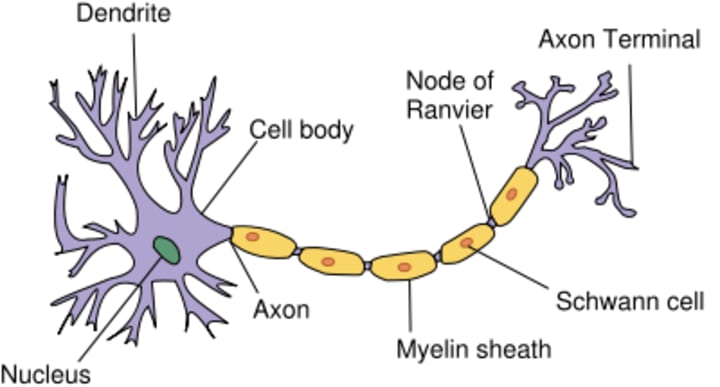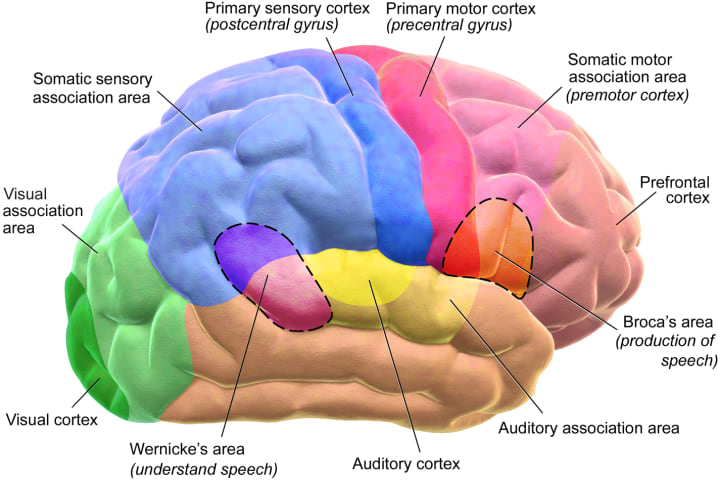The Mystery of Observation
A synesthesia guide

As we all know, each human being has the ability to sense certain aspects of their surroundings. We see colors and figures, we hear sounds and music, we smell, we taste, we touch.. Yet neuroscientists were able to prove that some people have a condition that mixes up the whole sensory system. Smelling colors, seeing sounds.. How is it possible? How can these beings sense things that we shouldn’t be able to sense?
Definition of synesthesia
People often presume that every separate sensory modality has specific stimuli in the brain that process it. It differs in the case of synesthesia (Greek; syn = together, aesthesia = sensation). The stimulation of one specific sensory modality automatically causes a perception of a second sensory modality. A certain sound evokes, for example, a color or figure. That is why the official meaning of synesthesia is: "the production of a sense impression relating to one sense or part of the body by stimulation of another sense in the same connected region". [1]
This psychological condition has been known since the description of Locke in 1690. It is therefore not a new phenomenon. It has appeared frequently in written literature from centuries ago and interests critical thinkers such as philosophers, psychologists and theologians. Scientists have also shown an interest in synesthesia as a concept and condition.
The different manifestations and the intuitive way in which it is experienced made it difficult to study and, of course, verify, causing many skeptical attitudes towards the condition. The recent neuroscientific evidence provided by functional imaging techniques has demonstrated brain activity that is consistent with the experiences indicated by synesthetics. For example, the color evoked by a second sensory modality, driven by a stimulated perception of a first sensory modality, activates regions in the brain that normally respond to color as a first modality. The question of whether synesthesia is therefore a "real" phenomenon is no longer an issue. [2]
The parts of the brain concerned
Sensory perceptions are made with the help of stimuli. The stimuli are converted into impulses (electrical signals), which are brought via sensory nerves to all kinds of sensory areas in the cortex. All senses have specific stimuli to which they respond. To create an impulse, it must be strong enough to reach the specific threshold. So if there is a (too) weak incentive, you will not perceive it.
The information enters the central nervous system via sensory pathways consisting of dendrites. This transport is provided and carried out by sensory neurons. Each of these neurons consists of one dendrite that transports the impulses. The length depends on how far the area that receives stimuli is from the central nervous system.

The cell bodies to which it is transported lie just outside the central nervous system. That is why the transport is taken over by switch cells. They run through the thalamus, which ensures that the impulse ends up in the right area of the cortex. The cortex is divided into a number of areas. In the motor cortex and the separate sensory areas is a separate area for each sense (see the image for the classification). Every sense has a "primary area" and an association area in which the information is compared to past experiences. This entire process of recording and linking information from the outside world is called sensory integration. [3]

It was only recently discovered that visual and sensory impressions were stored in different parts of the brain than previous observations and memories.
Maartje C. de Jong: “External and internal information, so new impressions and our memory, are inextricably linked in our brain. This has an undeniable influence on our perception: what we see cannot be an exact representation of the world around us. "You look with your eyes, but you see with your brain," they say, and it’s true. The reality is an interpretation of the brain, which differs per person, because different memories are present in each of our heads.” [4]
Observations that we receive in our brain undergo a so-called "coloring" through our memory.
Many theories state that there is something related to this view in synesthesia, but at a higher level. Instead of our memories ensuring that perceptions are viewed from a different perspective, memories ensure that specific stimuli are perceived in different ways. Synesthesia is in many cases caused by letters, numbers, words or sounds that we often had to identify in our childhood. Synesthesia also occurs in adults who were born blind and learned to discover the world through other senses, such as sense of smell or feeling objects, and then regained their sight. They indicate, for example, that they cannot properly perceive or understand animals without first touching a statue of the specific animal, or understand the concept of bread without first having smelled the odor. [2]
So there is also sensory integration in synesthesia, but an impulse is then processed in a second sensory modality, which has been triggered by the first impulse.
The ancient Greeks
Synaesthesia has appeared very early in the written literature. The Ancient Greeks observed their surroundings and discovered that people have separate organs to observe, including the eyes, nose and ears. This made them wonder how separate observations were combined. They did not specifically refer to the condition of synaesthesia, but it did raise the question of what synaesthesia is about: How can human beings experience a unity in the multitude of sensory impressions? [5]
Aristotle (384 BC-322 BC), a famous Greek philosopher and scientist, argued that this was caused by something he called sensus communis . It would perceive and combine the common similarities between the observations of the separate "observation bodies". This idea of Aristotle had a lot of influence on the philosophers and scientists who dealt with the same issue in the Middle Ages. [6]
The middle ages
A great example is the system of Thomas Aquinas (1225-1274), in which he presented three chambers in the brain.
The first room consists of sensory impressions that are created by external senses and were perceived by common sense (sensus communis). This room stimulates the imagination and the fantasy (imagunativa, fantasia).
The second chamber determines the cognition (cognitativa), the judgment (aestimativa) and reason (ratio). It determines the value of an observation with the help of memories (memorativa). These values and memories are stationed in the third room. [7]

This theory explains how people would experience a unity in the many different sensory impressions that are gained during perception, but not how, specifically, synesthetic perceptions are created. Observing colours in sound, or vice versa, is not common, and different synesthetics that disagree on a colour or sound that fits a particular vision or letter has nothing to do with common sense. [8]
The enlightenment and the renaissance
This theory was further tested by other scientists and philosophers in the Enlightenment and later in the Renaissance. Isaac Newton (1642-1727) stated that the tone of specific music would correspond to the frequency of a specific color. [9]
John Locke’s (1632-1704) idea corresponded with this:
“A studious blind man, who might have beat his head about visible objects, and made use of the explanation of his books and friends, to understand those names of light and colours which often came in his way, bragged one day, That he now understood what scarlet signified. Upon which, his friend demanding what scarlet was? The blind man answered, It was like the sound of a trumpet.”
This can literally be included as synesthesia, because it matches the condition, but can also be understood figuratively. A number of philosophers, including these two, began to recognize that sensory perceptions could differ from the physical environment. To explain this, the German philosopher Alexander Gottlieb Baumgarten (1714-1762) stated that not only the human intellect but also human senses have the capacity to know and perceive. The cognition (perception) of these senses, however, differ from the rational cognition by the human intellect. The rational cognition by the intellect uses logic and reason, but the cognition of the senses immediately perceives aesthetic qualities. This means that senses, for example, perceive the beauty of a specific tone or melody in a series of other melodies, because it seems to make more sense than the others or is considered more beautiful (Gestalt). In France, the philosopher Jean-Jacques Rousseau (1712-1778) made an equal distinction between raison sensitive and raison intellectual. Senses were considered creative and active organs of human perception; he recognized that the possibilities of using common sense differed per person. [9]
Based on this, the German philosopher Immanuel Kant (1724-1804) made an important distinction between the sensus communis and the sensus communis aestheticus. The first would be the same for everyone: to observe similar properties in different sensory domains. The second would have individual differences for everyone. It would be a personal ability to perceive special aesthetic qualities in multisensory domains.
These theories are all based on aesthetics, the specified area of philosophy: beauty theory. However, synesthetic observations are not always beautiful or "aesthetic". In the twentieth century, this theory (based on Gestalt) was reformulated in a way that it resembled a general theory of human perception. In this view, the idea of universal beauty was not regarded as essential to Gestalt, but rather as the inner necessity of perception.
Around the same time, Gestalt psychologists, such as Max Wertheimer, Wolfgang Köhler and Eich von Hornbostel, presented a more radical form of human perception with a distinct condition. They suggested that at first glance a Gestalt is observed, which mixes itself as one integral image. Component elements are only noticed when looking in detail at colors, figures, sounds and smells.
However, this still does not explain the synesthetic observations. They may be more sensitive to the environment and the way in which they are perceived, but why is a certain sound perceived by one person in a specific colour, but for another as a specific taste?
The modern age
Maurice Merleau-Ponty (1908-1961) stated around the 1950s that experiences are based on the human body. This explains the "unity of senses". The human body is a subjective sense for every person. All kinds of stimulations of your body create reactions that blend into a whole series of impressions before you realize them. Your body supposedly forms your sensory experience on an unconscious level, which you are only a little aware of. This unconscious body experience is, supposedly, "synesthetic". The sensory perceptions and impressions correspond to this unconscious level. Because experiences are personal for everyone, therefore differs for everyone.
Finally the German neuropsychologist Hinderk Emrich (1943) and the American neuropsychologist Vilayanur Ramachandran (1951) stated that the plasticity of the brain the autonomous organization and reorganization of sensory information enable. There are many scientists who are still researching synaesthesia and how it works in the brain, such as Richard E. Cytowic. [10]
In conclusion, the origin of the discovery of synaesthesia is spread over a long period of time. It originated from the Ancient Greeks, but was further analysed in the enlightenment and the renaissance, and is still being researched in present day.
Although it’s clear how sensory systems work, it’s not clear what causes them to mingle with each other, no matter how close scientists have come. Still, they are making huge improvements and insane progress. Who knows, maybe observation isn’t as mysterious as it seems to be.
Quoted works:
[1]: Synesthesia: a union of senses (Massachusetts: Richard E. Cytowic, 2002), xii
[2]:Synesthesia – Perspectives from cognitive neuroscience (Oxford: Lynn C. Robertson, 2005), vii
[3]: Sensorische zenuwen, transporteurs van waarnemingen (Redactie Natuurinformatie Naturalis, Bas Blankevoort, 2007), http://www.natuurinformatie.nl/nnm.dossiers/natuurdatabase.nl/i004326.html
[4]: Brein kleurt waarnemingen met opgeslagen herinneringen (NWO, 2015), https://www.nwo.nl/actueel/nieuws/2015/magw/brein-kleurt-waarnemingen-met-opgeslagen-herinneringen.html
[5]:The Hidden Sense: Synaesthesia in Art and Science (Massachusetts: Cretien van Campen, 2007), 152
[6]: White, TA (2005). Commentary on Aristotle's "On Sense and What Is Sensed" and "On Memory and Recollection". Washington DC: Catholic University of America Press.
[7]Commentary on Aristotle's "On Sense and What Is Sensed" and "On Memory and Recollection" by Thomas Aquinas (Washington DC: translated by Kevin White), 21-35, 53/54, 185/186
[8]: Instruments to Perform Color-Music: Two Centuries of Technological Experimentation (Kenneth Peacock, Leonardo 21 No. 4, 1988), 397-406.
[9]: An Essay Concerning Human Understanding , (John Locke, 1689) Book III, Chapter IV, section 11
[10]: The Hidden Sense: Synaesthesia in Art and Science (Massachusetts: Cretien van Campen, 2007), 153-156







Comments
There are no comments for this story
Be the first to respond and start the conversation.